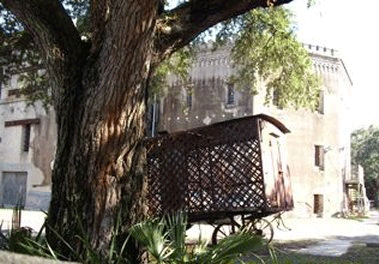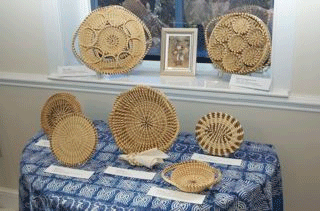After a stormy night, we awoke this morning to sunshine and perfect 65 degree weather. We spent the day touring Charleston and the Sea islands with Al Miller of Sites and Insights Tours. Mr. Miller specializes in Black history tours – he’s a wonderful guide and raconteur. He speaks Gullah, and he spent part of the ride teaching us Gullah phrases. He also loves to sing, so much of the tour was spent singing and clapping – one of our favorites was “We are Climbing Jacob’s Ladder.” We visited numerous sites in downtown Charleston, then had a delicious meal of authentic Gullah cuisine at a restaurant in nearby Mount Pleasant.
Then it was off to James and John Islands. At James Island we stopped at the McCleod Plantation. Owned by the Historic Charleston Foundation, the plantation has changed little since the nineteenth century and is not generally open to the public. So it was just us, wandering around the grounds of the plantation, standing in slave cabins, contemplating the lives the former residents led.
At John’s Island, we stopped to admire the Angel Oak Tree. This massive tree, which residents claim is up to 1500 years old, is unlike anything we had ever seen. We lingered under it and took lots of pictures.
On the way back to the hotel, we stopped briefly at the Avery Institute, where among our favoirte exhibitions was “Sweetgrass:A Living Legacy of Family and Community.” The Sweetgrass basket art form was brought to America by West African slaves, many of whose descendents still live in the area and continue to make these baskets. The youngest basket maker whose work we admired was only four!
Student responses
Peter: Today we took a bus tour of Charleston and some of the surrounding areas of the city itself. I really enjoyed it because I got to see a lot of the city, and I’ve wanted to do that since we arrived. We went all over, but one place that really stuck out for me was the McLeod Plantation. It was the first time I had ever been to a slave plantation. We got to take a look inside slave quarters again, but it was much different than the Aiken House we went to yesterday. The living quarters were much smaller and as many people as could fit lived in these shack-like buildings. I took a moment and just sat under one of the trees on the plantation. I separated myself from the group and took some personal time to reflect on the moment. What would it have been like to have this plantation and what the eye could see be my entire world? That was what it was like for many of the slaves that lived there. They almost certainly would never travel around the world, and they may not even leave the land that they worked for all of their days. I wondered what it would be like to have this land be my home forever and know nothing else. For many of the slaves the horizon might as well been the edge of the planet because they were never going to see what was beyond. They were in bondage, they were trapped. They were slaves. This is the part of the trip where we get to walk the same land, breathe the same air and see the same thing that slaves saw over a century ago. This was an experience that is difficult to describe, but it was like we made a connection to the past, and came to an unspoken understanding with history. I’m looking forward to having more experiences like this on the trip in the very near future.






